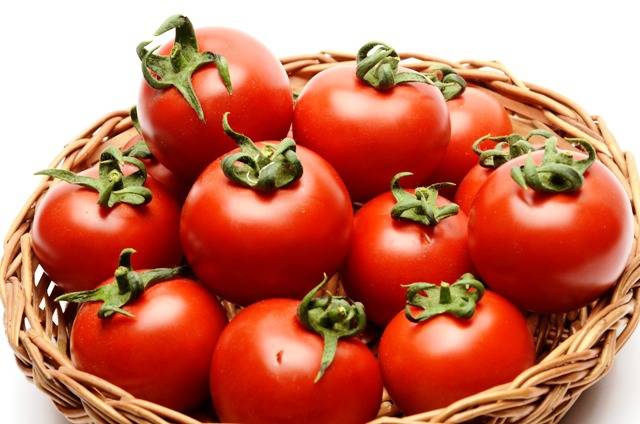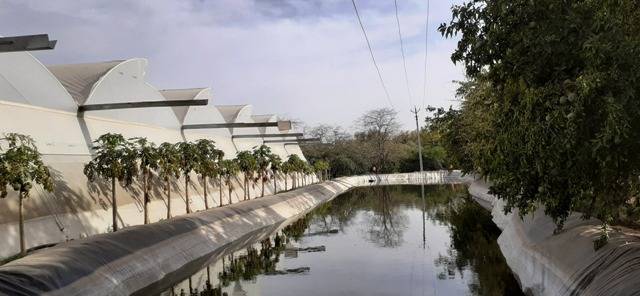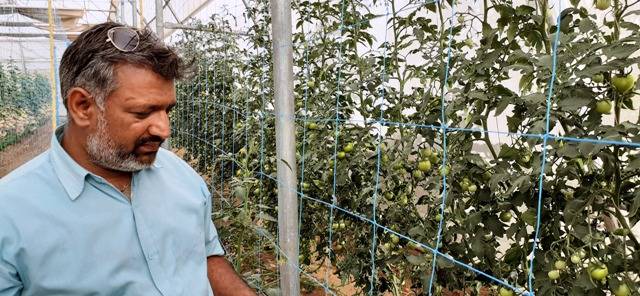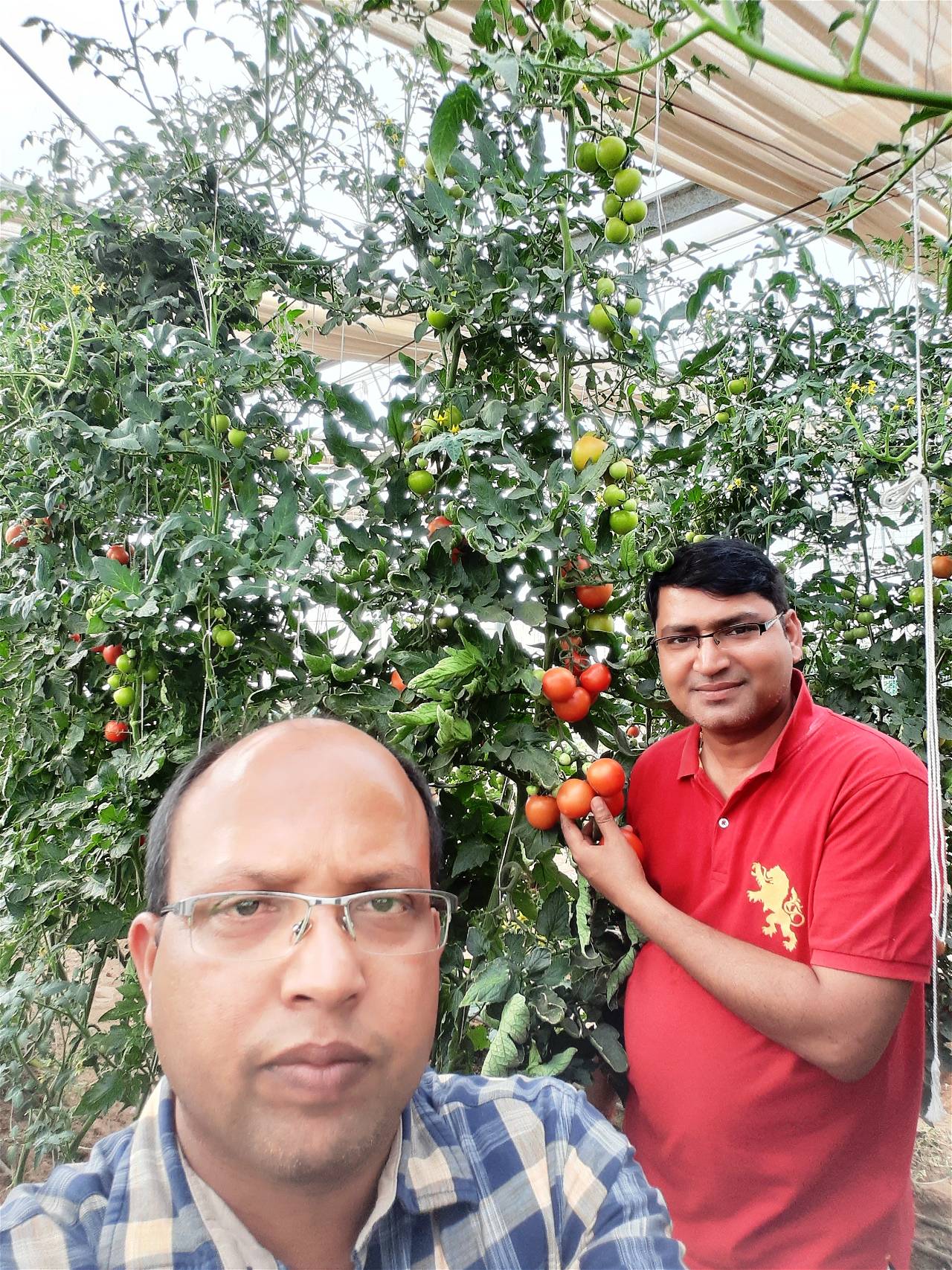
About Tomato hybrid DTPH-60
India is the second largest vegetable producer in the world next to China with a total production of 180 million tonnes from an area of 10.4 million hectares with the productivity level of 17.3 t/ha (NHB Database 2017-18). Though the vegetable sector is growing very fast, still we have to go a long way to meet the rising demand of the ever-increasing population. To achieve this target, we have to increase our vegetable productivity by incorporation of newly developed hybrids and high yielding varieties as well as the adoption of various technologies, like, protected cultivation, drip and sprinkler irrigation, off-season vegetable production, container & terrace gardening etc. Many times farmers produce a good amount of cucumber, capsicum and tomatoes during the main season, which eventually leads to the market glut and fall in price. On the other hand, due to extreme weather conditions, it is difficult to grow high-value vegetables, like tomato, capsicum, cucumber etc. in open field condition especially during rainy and winter season. Therefore, polyhouse technology has been found very effective for off-season production as well as around the year production of these high-value vegetables.
For cultivation under protected condition, the varieties, as well as cultivation practices, are different from the open field condition. As present vegetables, like cucumber, tomato and capsicum are the most popular and commercially grown vegetables for the protected condition. As we know that tomato is a third important vegetable in India after potato and onion from a production point of view, which evident from its total production of 19.4 million tonnes and productivity level of 24.7t/ha at all India level (NHB Database 2017-18). Moreover, at present no hybrid of tomato is available with the public sector for protected condition and the private sectors are selling hybrid seeds at a very high cost

Keeping above in view, Division of Vegetable Science, ICAR-IARI have developed several genotypes /hybrids which are under processes of release to provide farmers seeds of these varieties/hybrids at reasonable prices and ensure production of high-value vegetables having quality fruits round the year. The most promising line hybrid DTPH-60 was demonstrated at Chomu, Jaipur Rajasthan on Farmers field during 2018-19. Performance of hybrid DTPH-60 is given in Table-1and 2. There commended cultural practices are also given in this article to raise a good crop.
The major advantage of growing vegetables under protected environment
-
High yield under protected structure due to the utilization of vertical space and enhanced crop duration.
-
Off-season and round the year production is possible without much effect of external environment depending upon the type of structure.
-
Cultivation is possible under different conditions, like, hilly area, dessert and even under snow dessert in different location-specific structure.
-
Efficient use of resources, like water, fertilizers, sunlight etc.
-
Produce with high quality due to optimum environmental condition throughout the growing period and less effect of abiotic and biotic stresses.

Salient features of tomato hybrid DTPH-60
-
It is a hybrid variety of tomato suitable for cultivation under protected condition.
-
Fruits are round, deep red in colour with an average fruit weight of 108 g.
-
The ripe red fruits have TSS 5.2 of Brix and lycopene content 6.0 mg/100g.
-
It gives an average yield of 8-10 kg/plant in 7-8 months’ crop duration.
-
The average yield potential is 15 q from 100 square meter area of the playhouse.
Performance of new tomato lines in station trial IARI, New Delhi
28 F1 cross combinations of tomato (Solanum lycopersicum L.) were evaluated under protected condition. Hybrid DTPH-60 recorded a total yield of 15.6 q from 100 sq. m. area, 5.2oBrix TSS and 5.8 mg/100g lycopene with an average fruit weight of 108g. Hybrid DTPH-60 was found at par to most popular private-sector tomato hybrid GS-600 for protected in yield and other traits (Table1).
Table 1: Mean performance of tomato hybrid line DTPH-60 at I.A.R.I, New Delhi during the winter season from 2017 to 2018.
|
Variety |
Yield (q/100 sq m. area)
|
Average yield (q/100 sq m. area) |
Aw. Fruit weight(g) |
TSS (%) |
||
|
2016 |
2017 |
2018 |
||||
|
PusaBahar (DTPH-60) |
14.4 |
16.5
|
15.8 |
15.6 |
108 |
5.2 |
|
GS-600 (Private Check) |
15.1 |
16.7 |
16.2 |
16.0 |
116 |
4.5 |

Performance of new tomato hybrid DTPH-60 under demonstration trial at Chomu, Jaipur, Rajasthan
Hybrid DTPH-60 was demonstrated at 3 locations i.e. in naturally ventilated polyhouse of Sh. Suresh Kumar Tanwar, Amariwali Dhani, Vill-Harota, Tehsil-Chomu, Distt. Jaipur, Rajasthan; low-cost polyhouse at Krishi Vigyan Kendra, Vill-Tankarda, Tehsil-Chomu, Distt. Jaipur, Rajasthan and naturally ventilated polyhouse of Sh. Chaman Saini, Vill-Kalighati Morija, Tehsil-Chomu, Distt. Jaipur, Rajasthan (Table2). The crop was transplanted on 15 September, 2018 under protected structure and standard cultivation practices were followed to raise a good crop as described below. Sh. Suresh Kumar Tanwar who is already a progressive farmer and used to grow parthenocarpic cucumber under polyhouse wanted to have an alternate crop.
By growing tomato hybrid DTPH-60 in 3312 square me polyhouse, he not only got an alternate crop but also got higher profit than cucumber. He could harvest 15.8 kg tomato from per meter square area of polyhouse. He could sell his tomato during first harvest in January @Rs. 27 per kg and overall he got an average price of Rs18 /kg. His cost of cultivation was Rs. 60 per square meter area of polyhouse with major cost on organic fertilizers, Rs. 40,000 (Farm yard manure, Mycorrhizae, Pseudomonas, Trichoderma, vermicompost), Rs. 26, 000/- on chemical fertilizers (N: P: K: @ 19:19:19, 0:050, 13:0:45,0:52:34, CaCO3, Boron, MgSO4 and CaCl2@0.5% spray, etc.), Rs. 20.000/- on pesticides, Rs. 80, 000/- on labour cost. He has water harvesting pond, which is sufficient for irrigation of crop under polyhouse. The polyhouse tomato was uniform in shape, size and colour, so he could easily sell it in Chomu Mandi. By selling the tomato he could get an average profit of Rs. 224 from per square meter area of polyhouse. Similarly, Rs, 75/- per square meter profit was earned under low cost small polyhouse at KVK, Chomu, was also encouraging. Sh. Chaman Saini, another progressive farmers of village Morija, who also invested as Mr. Suresh and had similar facilities could earn the profit of Rs167 from per square meter area of polyhouse.
It was also reported by farmers that this tomato hybrid DTPH-60 had resistant to leaf curl and other diseases of polyhouse. In this way it was found a very successful hybrid for the farmers of Jaipur region for increasing their income many fold through off-season cultivation of tomato under protected condition.
Table 2: Performance of DTPH-60 at Chomu, Jaipur, Rajasthan during September2017 to April 2019 under polyhouse at Chomu, Distt. Jaipur, Rajasthan
|
Sl. No. |
Place of demonstration/address of farmers |
Size of polyhouse |
Yield per meter square area of polyhouse (Kg) |
Cost of cultivation per meter square area of polyhouse (Rs.) |
Average selling price of tomato Per kg (Rs) |
Profit earned per meter square area of polyhouse (Rs) |
|
1. |
Sh. Suresh Kumar Tanwar, Amariwali Dhani, Vill-Harota, Tehsil-Chomu, Distt. Jaipur, Rajasthan Pin code-303707 |
3312 sq. m. Naturally ventilated |
15.8 |
65 |
18 |
224 |
|
2. |
Dr. N.K. Gupta, Scientist, Krishi Vigyan Kendra, Vill-Tankarda,Tehsil-Chomu, Distt. Jaipur, Rajasthan |
100 sq. m. Low cost |
12.0 |
45 |
10 |
75 |
|
3. |
Sh. Chaman Saini, Vill-Kalighati Morija, Tehsil-Chomu, Distt. Jaipur, Rajasthan. |
4080 sq.m. Naturally ventilated |
15.0 |
58 |
15 |
167 |
Crop production practices to be followed for tomato hybrid DTPH-60under protected condition
Climate
It requires relatively warm season for its growth and development. It is highly susceptible to frost. Environmental factors such as temperature, light intensity and humidity effect fruit set, fruit development, yield and quality. Fruit set is poor when temperature is either relatively low (less than 160C) or high (more than 350C). The ideal night and day temperature for fruit set and colour development is 200 -250C.
Sowing time
In North Indian plains, under fully controlled environment it can be planted from August and crop may last upto May, while under low cost polyhouse /naturally ventilated structure, transplanting is done in September and crop may last upto April.
Soil
Well-drained sandy loam soil is ideal for growing good crop. It prefers a pH of 6-7.
Seed rate
125 g/ha.
Nursery raising
Nursery should be raised either in polyhouse or insect proof net house. It should be raised in soilless media (cocopeat, perlite and vermiculite mixture) to produce disease free and healthy seedlings. The seedlings should be raised in portrays. Fine and sieved combination of cocopeat: vermiculite: perlite in ratio of 3:1:1 by volume should be used as growing media. The filled protrays should be kept inside poly house/insect proof net house. One seed should be sown in each holes of protrays during last week of September after treating them with thiram @ 3g/kg seed. Immediately after sowing the seed, light irrigation should be given by watering can containing captaf @ 2g/litre of water. After one week of sowing again new seeds should be sown where seed germination could not take place. In soilless media, nutrients are applied in the form of N: P: K (1:1:1) @ 140 ppm once a week through the fine sprinkler to maintain the uniformity in application of nutrients. After 22-25 days of sowing, when the seedlings became 10-12 cm long and four true leaves had emerged, it should be kept for 2-3 days for hardening by holding irrigation for two days. Hardening of seedlings before transplanting is very effective in reducing transplanting shock and also resulted in better crop stand.
Transplanting
Transplanting should be done on both sides of 10 cm raised bed of 0.75-1.0 m width. There should be 45 cm distance between two beds. The seedlings should be transplanted at 0.60 m distance within a row on both sides of the raised bed. It should be planted under drip irrigation system for efficient use of water and fertilizers.
Manure and fertilizers
Soil testing must be done to determine the soil fertility of protected environment and the deficiency of nutrients must be supplemented as and when required. In general, about 25-30 metric tonnes per hectare of well rotten farmyard manure should be added at the time of preparation of land. In addition, 80 kg phosphorus and 90 kg potash is added at the time of land preparation before transplanting. 150 kg of nitrogen is applied in split doses, one third at the time of transplanting and other two third in the form of four top dressings, first at 25-30 days after transplanting, second after 50-60 days after transplanting or flowering, third after first picking and fourth after second picking. Foliar spray of 1% urea is beneficial and it should be applied after every picking later on. A mixture of micronutrients (especially calcium and boron) should also be applied at the time of flowering @ 0.5% water solution.
Irrigation
It is necessary to maintain even moisture supply, as overwatering is harmful. Water is essential at the time of flowering and fruiting. Adequate moisture also helps in better colour development. Irrigation is applied at 8-10 days’ interval in winter season whereas during summer months, irrigation is applied at 4 days’ interval depending upon weather conditions. If possible drip facility should be installed for efficient irrigation and fertigation. Mulching with black polythene mulch helps in conservation of soil moisture and weed management.
Intercultural operations
Weeds are often a limiting factor in tomato production as they share light, water, nutrients and space, harbour insect pests and diseases. Frequent hoeing should be done as often as necessary to control weeds. Tomato bed before mulching and transplanting should be drenched with Stomp @ 2 ml/ liter solution for controlling pre-emergence weeds.
Training, pruning and trellising
Staking is an important operation for tomato under protected condition. Staking should be done 20-25 days after transplanting. The plants should be loosely tied on vertical stakes. The timely staked plants produce more and better quality fruits. All the side branches/shoots should be removed/pinched at early stage to maintain single stem. Plants are supported by plastic wire or blinder twine loosely anchored with plastic clip at base of plant to overhead support wires running to the length of row of bed. Overhead wires running over the row of the bed are fitted 8-10 feet above and firmly supported with structure. Stem/vine of the plant is either fitted in round plastic clip of one-inch diameter with hanging twine or twine is wrapped around stem below the leaves clockwise leaving top 15 cm shoot of the growing plant. Regular pruning of side shoots should be done for entire crop duration. After first harvest, the leaves touching the ground (upto one feet from ground) should be removed which improves air circulation and reduces disease incidence.
Pollination
Since tomato is a self- pollinated crop having bisexual flower, therefore normal flowering and fruiting takes place in sunny weather, however for better fruit setting in foggy or cloudy weather electric vibrators or air blowers or manual shaking can be used for effective pollination during 10 to 11 am and 2 to 3 pm in the day.
Harvesting
Harvesting starts 70-75 days after transplanting. Harvesting depends upon purpose for which they are harvested and distance over which they are to be transported. Tomato is harvested at mature green stage for long distance transportation. For short distance transportation fruits are harvested at pink stage and for processing fully ripe red colour tomatoes should be harvested.
Average yield
Yield depends climatic factors and culture practices. On an average, it gives fruit yield around 15 q/ 100 sq. m. area of polyhouse.
Plant protection
The warm, humid conditions and abundant food under protected conditions provide an excellent, stable environment for pest development. Sanitation, soil solarization, mulching and fumigation are done to manage pest in protected condition. Major pest of tomato under polyhouse are whiteflies and mites, which come inside with the workers due to frequent entry in the polyhouse. Nematode also a major problem in polyhouse. The polythene used as cladding material should have 200-micron thickness and UV stabilized. Similarly, insect proof net should be of 40 mesh. Building a screened foyer to create a double-door entry partially solve the problem of wind-carried insects. Our major emphasis should be on prevention of entry of pest inside the protected structure. The seedling should be raised in protected environment for transplanting. The lower or damaged leaves should be removed to make ground clear for proper ventilation and to avoid spread of pests. For whiteflies, aphids and leaf miner adults, yellow sticky cards (8″x12″) should be place @5/100 sq. m. area for control of pest in the protected environment. Hang the yellow sticky cards/ traps in the crop with the help of strings about 4″ to 6″ above the plant canopy. As the crop grows, cards can be moved up. Change the cards when more than 60-70% of the area is covered by trapped insect. For effective management of pest and diseases Integrated Pest Management (IPM) strategies to be followed. if require apply dicofol @2 ml /litre water to control mites and trizophos @1 ml/3 lit water to control whitefly. For fungal diseases mixture of 1g carbendazim and 1g mancozeb @per litre water solution can be applied.
Authors:
R.K. Yadav,
B. S. Tomar
Harshwardhan Choudhary
Zakir Husain and Sumanlata
Division of Vegetable Science, ICAR-IARI, New Delhi-12
Email: [email protected]












Share your comments